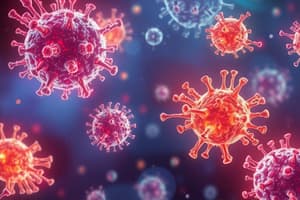Podcast
Questions and Answers
What are the broad mechanisms that contribute to antimicrobial resistance (AMR)?
What are the broad mechanisms that contribute to antimicrobial resistance (AMR)?
- Acquired resistance only
- Both intrinsic and acquired resistance (correct)
- Only genetic mutations
- Intrinsic resistance only
Which process is NOT a method by which bacteria acquire resistance genes?
Which process is NOT a method by which bacteria acquire resistance genes?
- Horizontal gene transfer
- Vertical gene transfer (correct)
- Recombination between genetic elements
- Mutation of existing genes
How does antimicrobial stewardship aim to address antimicrobial resistance?
How does antimicrobial stewardship aim to address antimicrobial resistance?
- By promoting the development of new antibiotics without restrictions
- By increasing the use of broad-spectrum antibiotics
- By reducing microbiome diversity in patients
- By ensuring proper use and minimizing unnecessary prescriptions (correct)
What is the primary function of antimicrobials in animals?
What is the primary function of antimicrobials in animals?
What is a significant factor that affects both pathogens and resident flora regarding antimicrobial use?
What is a significant factor that affects both pathogens and resident flora regarding antimicrobial use?
Which of the following best describes intrinsic resistance?
Which of the following best describes intrinsic resistance?
Which of the following statements about resistance genes is true?
Which of the following statements about resistance genes is true?
What is the primary role of antibiotics in veterinary medicine?
What is the primary role of antibiotics in veterinary medicine?
What role does horizontal gene transfer (HGT) play in antimicrobial resistance?
What role does horizontal gene transfer (HGT) play in antimicrobial resistance?
What does antimicrobial stewardship aim to achieve?
What does antimicrobial stewardship aim to achieve?
What might contribute to the development of antibiotic resistance in microbial populations?
What might contribute to the development of antibiotic resistance in microbial populations?
Which of the following is NOT a mechanism that confers antimicrobial resistance?
Which of the following is NOT a mechanism that confers antimicrobial resistance?
Which of the following strategies could enhance biosecurity against antimicrobial resistance?
Which of the following strategies could enhance biosecurity against antimicrobial resistance?
Which factor is essential for effective biosecurity in livestock operations?
Which factor is essential for effective biosecurity in livestock operations?
Which of the following statements about HACCP is accurate?
Which of the following statements about HACCP is accurate?
What type of antimicrobial is primarily used for treating infections in individual animals?
What type of antimicrobial is primarily used for treating infections in individual animals?
What is the primary purpose of administering antimicrobials for prophylaxis in livestock?
What is the primary purpose of administering antimicrobials for prophylaxis in livestock?
Which mechanism is NOT a way antimicrobials act on bacteria?
Which mechanism is NOT a way antimicrobials act on bacteria?
What characterizes acquired antimicrobial resistance?
What characterizes acquired antimicrobial resistance?
Which of the following is a goal of antimicrobial stewardship?
Which of the following is a goal of antimicrobial stewardship?
Which of the following is an example of a mechanism that can confer antimicrobial resistance?
Which of the following is an example of a mechanism that can confer antimicrobial resistance?
In HACCP principles, what is critical for effectively preventing microbial contamination?
In HACCP principles, what is critical for effectively preventing microbial contamination?
What does the term 'metaphylaxis' refer to in livestock antimicrobial use?
What does the term 'metaphylaxis' refer to in livestock antimicrobial use?
Which of the following is NOT a consequence of antimicrobial resistance?
Which of the following is NOT a consequence of antimicrobial resistance?
Flashcards
Antimicrobial
Antimicrobial
Any substance that kills or inhibits the growth of microorganisms, like bacteria, viruses, fungi, or parasites, while causing minimal harm to the host.
Antibacterials
Antibacterials
Refers specifically to drugs that target and kill bacteria.
Antivirals
Antivirals
Drugs used to combat viral infections.
Antifungals
Antifungals
Signup and view all the flashcards
Antiparasitics
Antiparasitics
Signup and view all the flashcards
Antimicrobial therapy
Antimicrobial therapy
Signup and view all the flashcards
Prophylactic antimicrobial use
Prophylactic antimicrobial use
Signup and view all the flashcards
Antimicrobial resistance (AMR)
Antimicrobial resistance (AMR)
Signup and view all the flashcards
Prophylaxis
Prophylaxis
Signup and view all the flashcards
Metaphylaxis
Metaphylaxis
Signup and view all the flashcards
Growth Promotion
Growth Promotion
Signup and view all the flashcards
How antimicrobials work
How antimicrobials work
Signup and view all the flashcards
Antimicrobial Action: Inhibiting Cell Wall Synthesis
Antimicrobial Action: Inhibiting Cell Wall Synthesis
Signup and view all the flashcards
Antimicrobial Action: DNA Replication and Synthesis
Antimicrobial Action: DNA Replication and Synthesis
Signup and view all the flashcards
Antimicrobial Action: Inhibiting Protein Synthesis
Antimicrobial Action: Inhibiting Protein Synthesis
Signup and view all the flashcards
What is Antimicrobial Resistance (AMR)?
What is Antimicrobial Resistance (AMR)?
Signup and view all the flashcards
What is Intrinsic Resistance?
What is Intrinsic Resistance?
Signup and view all the flashcards
What is Acquired Resistance?
What is Acquired Resistance?
Signup and view all the flashcards
What are Antimicrobial Resistance Genes (ARGs)?
What are Antimicrobial Resistance Genes (ARGs)?
Signup and view all the flashcards
What are Antimicrobial Resistance Operons (AROs)?
What are Antimicrobial Resistance Operons (AROs)?
Signup and view all the flashcards
What is Horizontal Gene Transfer (HGT)?
What is Horizontal Gene Transfer (HGT)?
Signup and view all the flashcards
What are Mobile Genetic Elements (MGEs)?
What are Mobile Genetic Elements (MGEs)?
Signup and view all the flashcards
What is Antimicrobial Selection Pressure?
What is Antimicrobial Selection Pressure?
Signup and view all the flashcards
Study Notes
Antimicrobial Resistance (AMR)
- Antimicrobial resistance (AMR) is a significant issue, impacting both animals and humans.
- AMR is not a new problem, rather the issue of bacteria resisting the effects of antimicrobials is well-documented.
- Natural selection plays a role, as bacteria are resistant to changes
- The use of antimicrobials leads to an inevitable selection of resistant bacteria.
- Mechanisms for AMR include existence of ancient genes, acquired mechanisms, acquired gene mutations that create new genes, horizontal gene transfer, and recombination between genetic elements.
Antimicrobial Use in Livestock
- AMR/antimicrobial use (AMU) in livestock includes therapy for individual animals (e.g., treating a sick piglet).
- AMU also includes treating groups of animals (e.g., broilers with E. coli infection).
- Antimicrobial use in livestock also includes prophylactic measures (preventing disease in a group).
- AMU also encompasses instances of growth promotion, where antimicrobials are given to livestock to improve performance (e.g. grower phase pigs).
AMR Quandaries
- AMR impacts human and animal populations dramatically.
- Prevalence of AMR is relatively widespread amongst both animals and in humans.
- Prevalence is higher for AMR in livestock (10-15%) compared to humans (24%).
- Antimicrobials are used in a variety of settings, from farm settings to hospitals, impacting health generally.
Mechanisms of Action
- These include cell wall synthesis inhibition, DNA replication, DNA synthesis inhibition, and protein synthesis inhibition.
- Specific examples of agents related to each mechanism are included.
Common Abbreviations/Terms
- AMR - antimicrobial resistance
- AMU - antimicrobial use
- ERP - expected resistance phenotype (New!)
- ARG-antimicrobial resistance gene
- ARO - antimicrobial-resistant organism
- HGT – horizontal gene transfer
- ICES - Integrative conjugative elements
Ecology of AMR Genes
- Common focus for ecology of AMR genes is the effect of AMU on various pathogens.
- Bacteria may serve as hosts for resistance genes that can spread among other species.
- This spread happens independently of phylogenetic relationships among the bacteria.
- This resistance spread occurs globally.
Current AMU Policy in Canada
- Current policy concerning AMR (antimicrobial resistance) involves surveillance reporting, restrictions on importation, licensing, and approval processes, with consideration for alternative products.
Antimicrobial Stewardship
- Antimicrobial stewardship involves a shift towards more prudent and judicious use of antimicrobials.
- Stewardship emphasizes personal responsibility in the use of antimicrobials and in the management of entrusted things.
- The primary objective of antimicrobial stewardship is optimized clinical outcomes, while simultaneously minimizing harm from minimizing unintended consequences and dissemination of resistance.
Learning Objectives
- The learning objectives of an associated course or presentation include explaining antimicrobials, their use in animals, illustrating mechanisms of action, describing antimicrobial resistance, identifying mechanisms that cause resistance, effects of resistance, and the definition of antimicrobial stewardship.
Studying That Suits You
Use AI to generate personalized quizzes and flashcards to suit your learning preferences.
Related Documents
Description
This quiz explores the critical issue of antimicrobial resistance (AMR) and its implications for both humans and livestock. It covers the mechanisms behind AMR, the role of natural selection, and the various ways antimicrobials are used in livestock, including treatment and prophylactic measures.





